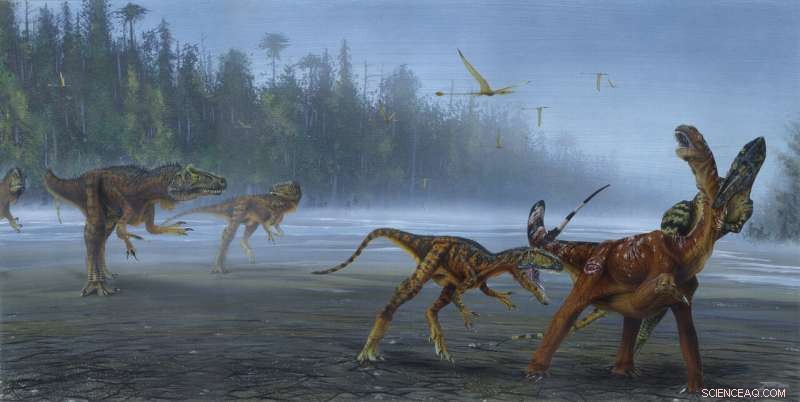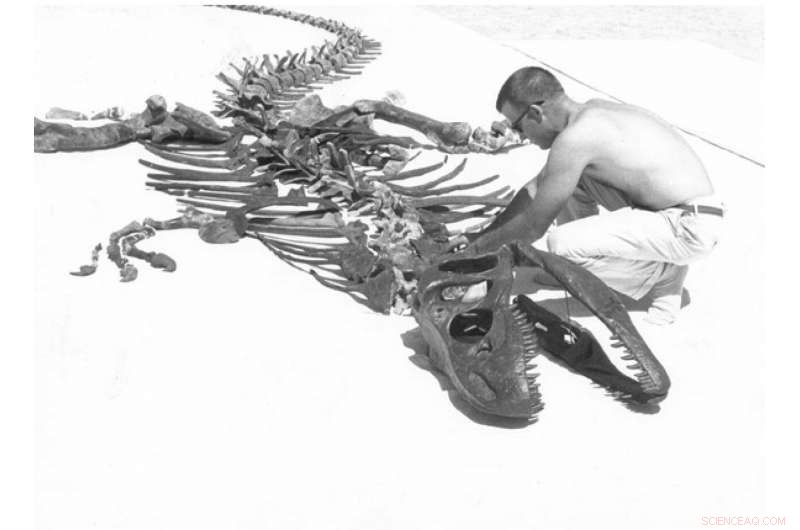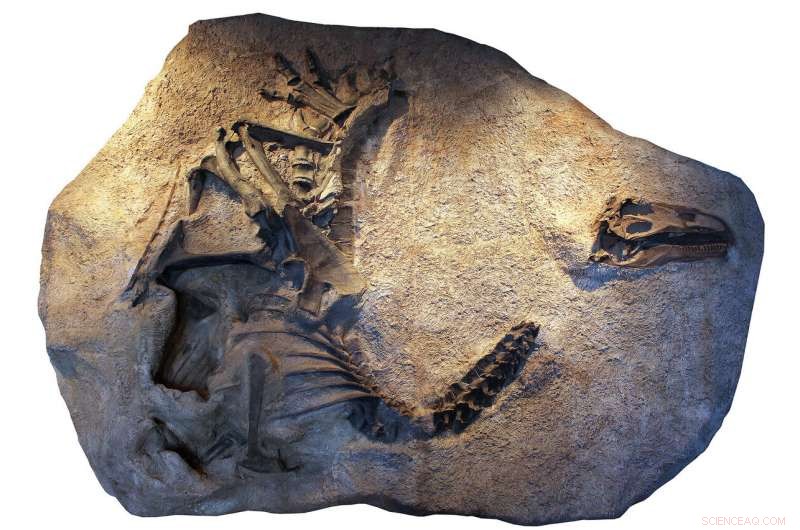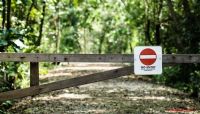Ny art af Allosaurus opdaget i Utah

Allosaurus jimmadseni angreb juvenil sauropod. Kredit:Todd Marshall
En bemærkelsesværdig ny art af kødspisende dinosaurer er blevet afsløret på Natural History Museum of Utah. Palæontologer udgravede det første eksemplar i begyndelsen af 1990'erne i Dinosaur National Monument i det nordøstlige Utah. Den enorme kødæder beboede flodsletterne i det vestlige Nordamerika under den sene juraperiode, mellem 157-152 millioner år siden, hvilket gør den til den geologisk ældste art af Allosaurus , før det mere kendte statsfossil i Utah, Allosaurus fragilis . Den nyligt navngivne dinosaur Allosaurus jimmadseni , blev annonceret i dag i det videnskabelige tidsskrift med åben adgang PeerJ .
Arten tilhører allosauroiderne, en gruppe af små til store, tobenede kødædende dinosaurer, der levede i jura- og kridtperioden. Allosaurus jimmadseni , har flere unikke egenskaber, blandt dem et kort smalt kranium med lave ansigtskamme, der strækker sig fra hornene foran øjnene frem til næsen og en forholdsvis smal kraniebagside med en flad overflade til bunden af kraniet under øjnene. Kraniet var svagere med et mindre overlappende synsfelt end dens yngre fætter Allosaurus fragilis . Allosaurus jimmadseni udviklet sig mindst 5 millioner år tidligere end fragilis, og var det mest almindelige og det øverste rovdyr i sit økosystem. Den havde relativt lange ben og hale, og lange arme med tre skarpe kløer. Navnet Allosaurus oversættes som "forskellige krybdyr, " og anden del, jimmadseni, hædrer Utah State Palæontolog James H. Madsen Jr.
Efter en indledende beskrivelse af Othniel C. Marsh i 1877, Allosaurus blev hurtigt den bedst kendte - ja den kendetegnende - Jurassic theropod. Den taksonomiske sammensætning af slægten har længe været en debat gennem de sidste 130 år. Palæontologer hævder, at der er et sted mellem en og 12 arter af Allosaurus i Morrison-formationen i Nordamerika. Denne undersøgelse genkender kun to arter - A. fragilis og A. jimmadseni .
"Tidligere palæontologer troede, at der kun var én art af Allosaurus i Jurassic North America, men denne undersøgelse viser, at der var to arter - den nyligt beskrevne Allosaurus jimmadseni udviklede sig mindst 5 millioner år tidligere end sin yngre fætter, Allosaurus fragilis , " sagde co-lead forfatter Mark Loewen, forskningsassistent ved Natural History Museum of Utah, og lektor i Institut for Geologi og Geofysik ved University of Utah ledede undersøgelsen. "Skallen af Allosaurus jimmadseni er lettere bygget end sin senere slægtning Allosaurus fragilis , tyder på en anderledes fodringsadfærd mellem de to."
"At genkende en ny dinosaurart i klipper, som er blevet intenst undersøgt i over 150 år, er en enestående opdagelsesoplevelse. Allosaurus jimmadseni er et godt eksempel på, hvor meget mere vi skal lære om dinosaurernes verden. Mange flere spændende fossiler venter på opdagelse i Jurassic-klipperne i det amerikanske vest, " sagde Daniel Chure, pensioneret palæontolog ved Dinosaur National Monument og medforfatter af undersøgelsen.
George Engelmann fra University of Nebraska, Omaha opdagede oprindeligt det oprindelige skelet af den nye art i Dinosaur National Monument i 1990. I 1996, flere år efter at det hovedløse skelet blev indsamlet, det radioaktive kranium, der tilhører skelettet, ved hjælp af en strålingsdetektor af Ramal Jones fra University of Utah. Både skelet og kranium blev udgravet af hold fra Dinosaur National Monument.
"Big Al, "et andet eksemplar, der tilhører den nye art, blev opdaget i Wyoming på United States Bureau of Land Management (BLM) jord i 1991 og har til huse i samlingerne på Museum of The Rockies i Bozeman, Montana. Tidligere troet at tilhøre Allosaurus fragilis , "Big Al" var med i BBC's 2001 "Walking with Dinosaurs:Ballad of Big Al"-video. I løbet af de sidste 30 år, besætninger fra forskellige museer har indsamlet og forberedt materialer af denne nye art. Andre eksemplarer omfatter "Big Al Two" på Saurier Museum Aathal i Schweiz og Allosaurus materiale fra Dry Mesa Quarry i Colorado ved Brigham Young University.
"Denne spændende nye undersøgelse illustrerer vigtigheden af fortsatte palæontologiske undersøgelser på offentlige arealer i Vesten. Opdagelsen af denne nye taxon af dinosaurer vil give vigtig information om livet og tiderne for jura dinosaurer og repræsenterer en anden unik komponent af Amerikas arv, " sagde Brent Breithaupt, BLM regional palæontolog.

Palæontolog James Madsen Jr. samler et sammensat skelet af Allosaurus fra Clevland Lloyd Dinosaur Quarry Kredit:J. Willard Marriot Library ved University of Utah
Dinosaurer fra den tidlige Morrison-formation blev erstattet af nogle af de mest ikoniske dinosaurer fra den sene jura
Allosaurus jimmadseni boede på de halvtørre Morrison Formations flodsletter i det indre af det vestlige Nordamerika. De ældre klipper i Morrison Formation bevarer en fauna af dinosaurer, der er adskilt fra de ikoniske yngre Morrison Formation faunaer, der bl.a. Allosaurus fragilis , Diplodocus og Stegosaurus. Palæontologer har for nylig fastslået, at eksemplarer af denne nye dinosaurart levede flere steder i det vestlige indre af Nordamerika (Utah, Colorado og Wyoming).
Studieresumé
Dinosaurer var de dominerende medlemmer af terrestriske økosystemer under mesozoikum. Imidlertid, mønsteret for evolution og omsætning af økosystemer i den midterste mesozoikum er stadig dårligt forstået. Forfatterne rapporterer opdagelsen af det tidligste medlem af gruppen af allosauroider med stor krop i Morrison Formation-økosystemet, der blev erstattet af Allosaurus fragilis og illustrere ændringer erhvervet i slægten over tid. Undersøgelsen omfatter en dybdegående beskrivelse af hver knogle i kraniet og sammenligninger med kraniematerialer fra andre kødædende dinosaurer. Endelig, undersøgelsen genkender kun to arter af Allosaurus i Nordamerika med Allosaurus fragilis erstatter sin tidligere slægtning Allosaurus jimmadseni .
Faktaark:Vigtigste punkter i papiret
- En bemærkelsesværdig ny art af kødspisende dinosaurer, Allosaurus jimmadseni , er beskrevet ud fra to spektakulært komplette skeletter. Det første eksemplar blev gravet frem i Dinosaur National Monument, i det nordøstlige Utah.
- Allosaurus jimmadseni er kendetegnet ved en række unikke funktioner, including low crests running from above the eyes to the snout and a relatively narrow back of the skull with a flat surface to the bottom of the upper skull under the eyes. The skull was weaker with less of an overlapping field of vision than its younger cousin Allosaurus fragilis .
- At 155 million years old, Allosaurus jimmadseni is the geologically-oldest species of Allosaurus predating the more well-known State Fossil of Utah Allosaurus fragilis .
- Allosaurus jimmadseni was the most common and the top predator in its ecosystem. It had relatively long legs and tail, and long arms with three sharp claws.
Study design
- Comparison of the bones with all other known allosauroid dinosaurs indicate that the species possessed unique features of the upper jaw and cheeks (maxilla and jugal) and a decorative crest stretching from just in front of the eyes to the nose.
- Many of the comparisons were made with the thousands of bones of Allosaurus fragilis collected from the famous Cleveland-Lloyd Dinosaur Quarry administered by the Bureau of Land Management that are housed in the collections of the Natural History Museum of Utah.
- On the basis of these features, the scientific team named it a new genus and species of dinosaur, Allosaurus jimmadseni (translating to "Jim Madsen's different reptile").
- Allosaurus jimmadseni is particularly notable for its slender, narrow skull with short sharp nasal crests compared to its close relative and successor Allosaurus fragilis .
- The study was funded in part by the University of Utah, the National Park Service and the National Science Foundation.
New dinosaur name: Allosaurus jimmadseni
- The first part of the name, Allosaurus , (a·luh·SAW·ruhs) can be translated from Greek as the "other", "strange" or "different" and "lizard" or "reptile" literally to "different reptile". The second part of the name jimmadseni (gym-MAD-sehn-eye) honors the late Utah State Paleontologist James Madsen Jr. who excavated and studied tens of thousands of Allosaurus bones from the famous Cleveland-Lloyd Dinosaur Quarry in central Utah and contributed greatly to the knowledge of Allosaurus .
Size
- Allosaurus jimmadseni was approximately 26 to 29 feet (8-9 meters) long.
- Allosaurus jimmadseni weighed around 4000 lbs. (1.8 metric tonnes).

A cast of the skeleton and skull of Allosaurus jimmadseni as it was discovered and now on exhibit at Dinosaur National Monument in Utah. The original skeleton was molded and cast before it was taken apart and prepared for study and research. Credit:Dan Chure
Relationships
- Allosaurus jimmadseni belongs to a group of carnivorous dinosaurs called "allosauroids, " the same group as the famous Allosaurus fragilis .
- Other dinosaurs found in rocks containing Allosaurus jimmadseni include the carnivorous theropods Torvosaurus and Ceratosaurus; the long-necked sauropods Haplocanthosaurus and Supersaurus; and the plate-backed stegosaur Hesperosaurus.
- Allosaurus jimmadseni is closely related to the State Fossil of Utah, Allosaurus fragilis .
Anatomy
- Allosaurus jimmadseni was a two-legged carnivore, with long forelimbs and sharp, recurved claws that were likely used for grasping prey.
- Like other allosauroid dinosaurs, Allosaurus jimmadseni had a large head full of 80 sharp teeth. It was also the most common carnivore in its ecosystem.
Age and geography
- Allosaurus jimmadseni lived during the Kimmeridgian stage of the Late Jurassic period, which spanned from approximately 157 million to 152 million years ago.
- Allosaurus jimmadseni lived in a semi-arid inland basin filled with floodplains, braided stream systems, søer, and seasonal mudflats along the western interior of North America.
- Allosaurus jimmadseni represents the earliest species of Allosaurus i verden.
Discovery
- Allosaurus jimmadseni can be found in a geologic unit known as the Salt Wash Member of the Morrison Formation and its equivalents exposed in Colorado, Wyoming, and Utah.
- The first specimen of Allosaurus jimmadseni was discovered in the National Park Service administered by Dinosaur National Monument in Uintah County, near Vernal, Utah.
- Allosaurus jimmadseni was first discovered by George Engelmann of the University of Nebraska, Omaha on July 15, 1990 during a contracted paleontological inventory of the Morrison Formation of Dinosaur National Monument.
- Another specimen of Allosaurus jimmadseni known as "Big Al, " was found on land administered by the U.S. Department of the Interior's Bureau of Land Management in Wyoming.
- Further specimens of Allosaurus jimmadseni have been subsequently recognized in the collections of various museums.
- Allosaurus jimmadseni specimens are permanently housed in the collections of Dinosaur National Monument, Utah; the Museum of the Rockies, Bozeman, Montana; the Saurier Museum of Aathal, Switzerland; the South Dakota School of Mines, Rapid City, South Dakota; Brigham Young University's Museum of Paleontology, Provo, Utah; and the United States National Museum (Smithsonian) Washington D.C.
- These discoveries are the result of a continuing collaboration between the Natural History Museum of Utah, the National Park Service, and the Bureau of Land Management.
Excavation
- The first skeleton of Allosaurus jimmadseni was excavated during the summers of 1990 to 1994 by staff of the National Park Service's Dinosaur National Monument. The skeleton block was so heavy it required the use of explosives to remove surrounding rock and a helicopter to fly out the 2700 kg block. The head of the skeleton was missing
- The first bones of Allosaurus jimmadseni discovered included toes and some tail vertebrae. Later excavation revealed most of an articulated skeleton missing the head and part of the tail.
- The radioactive skull of the first specimen of Allosaurus jimmadseni , which had previously eluded discovery, was found in 1996 by Ramal Jones of the University of Utah using a radiation detector.
Preparation
- It required seven years to fully prepare all of the bones of Allosaurus jimmadseni .
- Much of the preparation was done by then Dinosaur National Monument employees Scott Madsen and Ann Elder, with some assistance from Dinosaur National Monument volunteers and students at Brigham Young University.
Andet
- The Natural History Museum of Utah houses the world's largest collection of Allosaurus fossiler, which are frequently studied by researchers from around the world.
- More than 270 National Park Service (NPS) areas preserve fossils even though only 16 of those were established wholly or in part for their fossils. Fossils in NPS areas can be found in the rocks or sediments of a park, in museum collections, and in cultural contexts (building stones, artifacts, historical legends, and documents).
- The United States Bureau of Land Management manages more land—247 million acres—than any other federal agency, and manages paleontological resources using scientific principles and expertise.
 Varme artikler
Varme artikler
-
 Sådan konverteres et decimal til et helt talTeknisk refererer en decimal kun til tal til højre for et decimalpunkt - for eksempel .325. Alt til højre for et decimalpunkt har automatisk en værdi, der er mindre end 1, så det kan ikke repræsentere
Sådan konverteres et decimal til et helt talTeknisk refererer en decimal kun til tal til højre for et decimalpunkt - for eksempel .325. Alt til højre for et decimalpunkt har automatisk en værdi, der er mindre end 1, så det kan ikke repræsentere -
 Udforsker brugen af strækbare ord i sociale medierLatterens træ. Dette stavetræ for strakte versioner af ordet ha viser mange af de forskellige måder, disse ord staves på, når de bliver strakt. Træets mønstre repræsenterer ordenes stavemåder, med det
Udforsker brugen af strækbare ord i sociale medierLatterens træ. Dette stavetræ for strakte versioner af ordet ha viser mange af de forskellige måder, disse ord staves på, når de bliver strakt. Træets mønstre repræsenterer ordenes stavemåder, med det -
 Sådan beregnes diameter kun med længde og breddeDiameter er længden på en linje, der berører to punkter på en cirkel, der passerer gennem midten. Diameter findes kun for cirkulære eller for cirkelbaserede objekter som en kugle eller cylinder, og de
Sådan beregnes diameter kun med længde og breddeDiameter er længden på en linje, der berører to punkter på en cirkel, der passerer gennem midten. Diameter findes kun for cirkulære eller for cirkelbaserede objekter som en kugle eller cylinder, og de -
 Studiet udforsker, hvad der virkelig gør en film vellykketAvatar, udgivet i 2009, blev den mest indbringende film nogensinde. Kredit:Flickr Til mere end $20 for en lørdag aften biografbillet biografgængere ønsker ikke at vælge en dud. Nu, ny forskning om
Studiet udforsker, hvad der virkelig gør en film vellykketAvatar, udgivet i 2009, blev den mest indbringende film nogensinde. Kredit:Flickr Til mere end $20 for en lørdag aften biografbillet biografgængere ønsker ikke at vælge en dud. Nu, ny forskning om
- Alt-du-kan-spise lossepladsbuffet staver problemer for fugle
- Hjemmeunderviste børn er langt mere socialt engagerede, end du måske tror
- Forskere udvikler et af verdens mindste elektroniske kredsløb
- Sådan bestemmes minimumskoefficienten for statisk friktion
- Hvad er klipcyklens trin?
- NASA-NOAA satellit tager et billede af den tropiske storm Higos i det Sydkinesiske Hav


